Tone ten is a tree growing in humid forest areas that we have seen numerous times between Luang Prabang and Phongsaly. It is very recognizable, particularly due to its foliage: it has a narrow, straight trunk, sometimes forked at the base, with long angular branches reaching toward the ground. Each of them is covered evenly and on the same side by two rows of thick, oval leaves, which are dark green on top and grey-green underneath, with profoundly marked nerves. Large clusters of floral buttons grow at the extremity of each branch. Each flower has six white petals, around a tuft of stamens. The flowers fall quickly, after which six fleshy sepals remain on the tree, forming a star, with the fruit in the centre of the formation, in a round, tough-skinned capsule.
This tree belongs to a very small botanical family comprised of only two genres and seven species. What interests us here is Duabanga grandiflora; the first part of its name stems from one of the minority languages of Tripura, a state in northeast India: Duyabangga. It is a species found in the lower areas of the rain forests of South and South-east Asia.
In Laos, this tree has numerous names: in Phongsaly, more often than not it is called tone lin ngo, one also hears tone sa phay. The latter name is interesting because “phay” applies to types of tiles made of grass and woven to cover the roofs of huts; now, the regular arrangement of the leaves on the branch of the Duabanga can make us think of tresses. In French, we have arbitrarily taken the commercial name for this wood: lampati. In fact, tone ten is a soft, smooth wood of a beautiful colour, from which one can make numerous objects: the Hmong use the wood in construction of their houses and to make pestles for pounding rice.
In international commerce, tone ten is suggested for making small pieces of furniture, veneers, packing cases, matches, toys, and any object in turned wood; one can also make pulp paper. Because this tree grows rapidly, we tell the wood merchants that it could be “the foundation of a lasting industry, without causing any loss of the rain forest… “
Most happily, the tone ten is not, to our knowledge, exploited industrially, nor does it appear on the lists maintained by the Centre for International Forestry Research of trees to be protected or replanted. One can, therefore, continue to enjoy its beautiful white flowers which are offered, so we were told by an elderly man we encountered, in Buddhist temples during the month of April.
Tone ten est un arbre des forêts humides que nous avons vu à plusieurs reprises entre Louang Prabang et Phongsaly. Il est très reconnaissable à l’architecture particulière de son feuillage; d’un tronc mince et droit, parfois formant une fourche à la base, partent de longues branches anguleuses qui se déploient vers le sol; chacune d’elle est couverte régulièrement et du même côté de 2 rangées de feuilles oblongues, épaisses, vert foncé sur le dessus, vert gris en dessous, aux nervures profondément marquées. C’est à l’extrémité de ces branches qu’apparaissent de grosses grappes de boutons floraux. Chaque fleur a 6 pétales blancs, qui tombent rapidement, autour d’une houppette échevelée d’étamines; après leur chute subsistent sur l’arbre 6 sépales charnus, en forme d’étoile avec au centre le fruit en formation; celui-ci est une capsule arrondie à l’enveloppe coriace.
Cet arbre appartient à une toute petite famille botanique qui ne compte que 2 genres et 7 espèces. Celle qui nous intéresse ici, Duabanga grandiflora, a été nommée à partir de son nom dans une langue indienne (Tripura), Duyabangga. C’est une espèce que l’on trouve dans les parties basses des forêts pluvieuses du Sud-est Asiatique et de la Chine.
En Lao cet arbre a plusieurs noms, à Phongsaly on le nomme plutôt tone lin ngo, on entend aussi tone sa phay; ce dernier terme est intéressant car « phay » s’applique aux sortes de tuiles d’herbe à paillote tressées pour couvrir les maisons ; or la disposition régulière des feuilles sur la branche de Duabanga peut en effet faire penser à un tressage. En français nous avons repris arbitrairement le nom donné dans le commerce à ce bois : lampati. En effet tone ten a un bois léger et lisse d’une belle couleur or avec lequel on peut faire de nombreux objets; chez les Hmong « le bois est employé dans la construction des maisons et la fabrication des pilons à riz ».
Dans le commerce international il est proposé pour fabriquer du petit mobilier, des plaquages, des caisses d’emballage, des allumettes, des jouets et tout objet en bois tourné; on peut aussi en faire de la pâte à papier. Comme il pousse très rapidement, nous disent les marchands de bois, il peut être « la base d’une industrie durable sans dommage pour la forêt pluvieuse »…
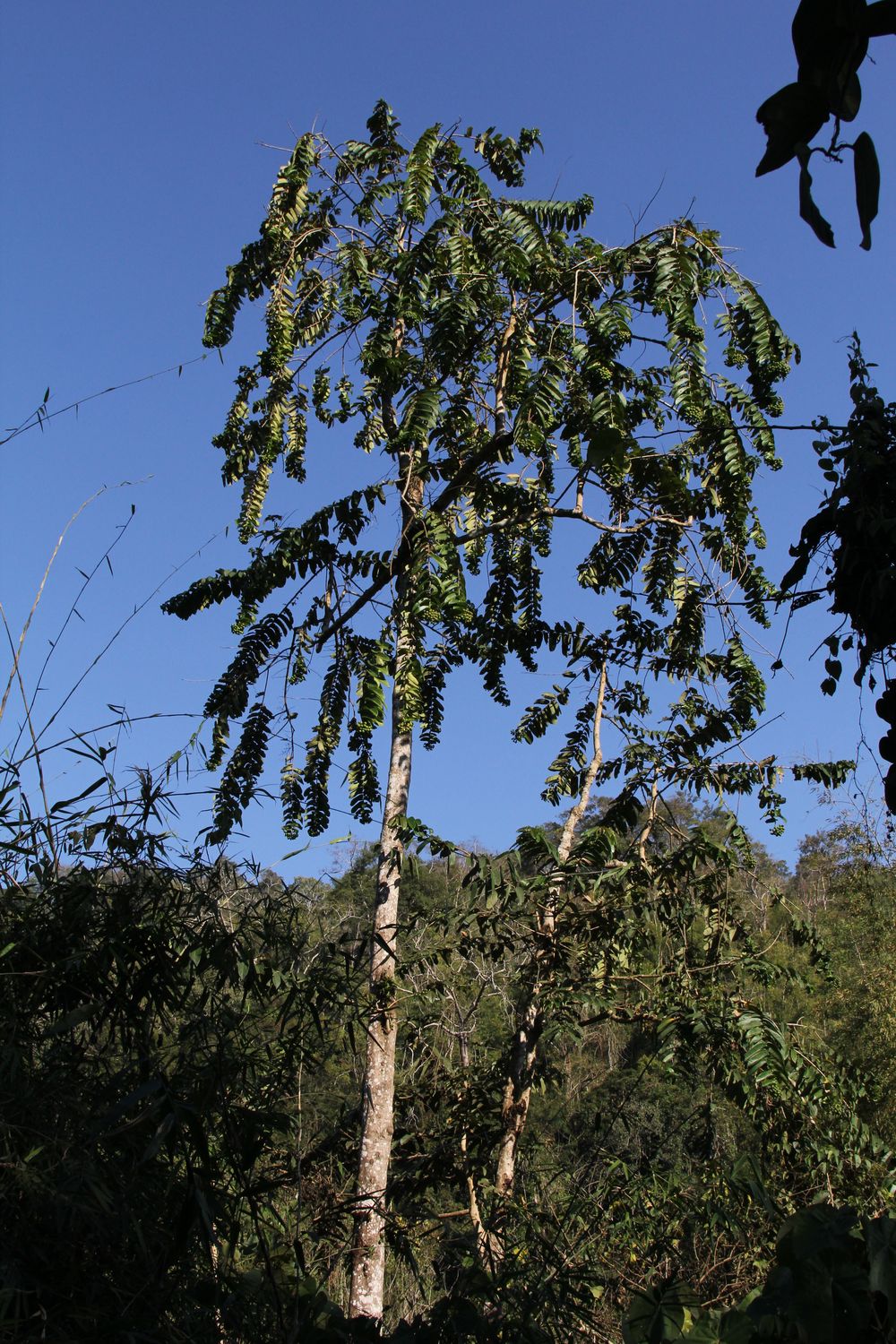
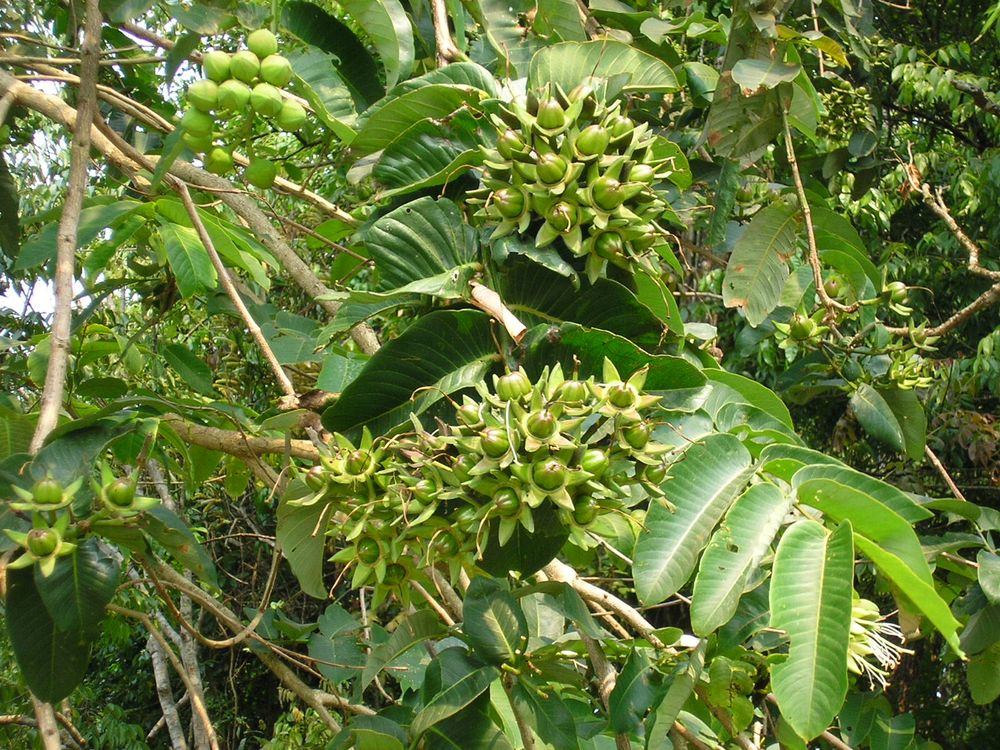
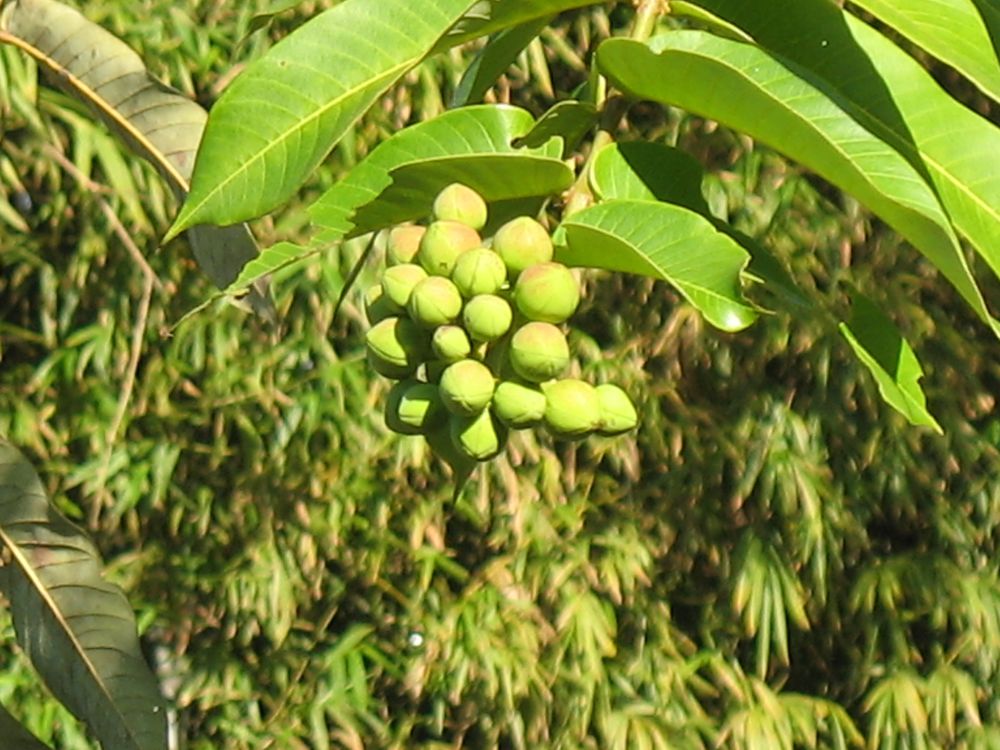
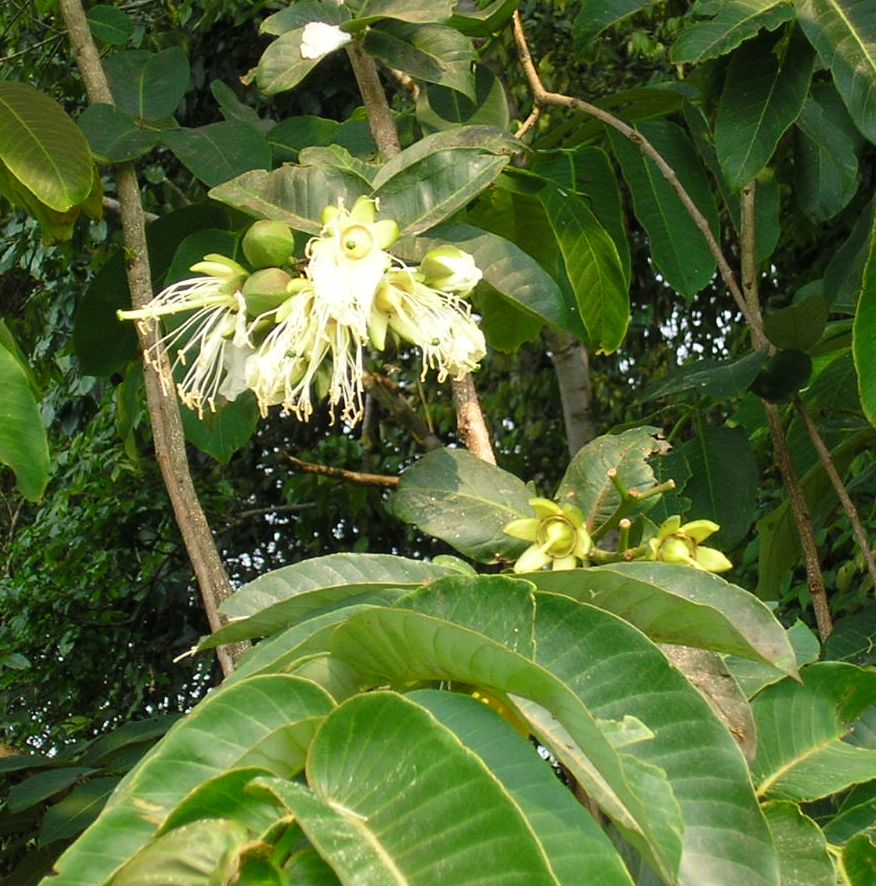
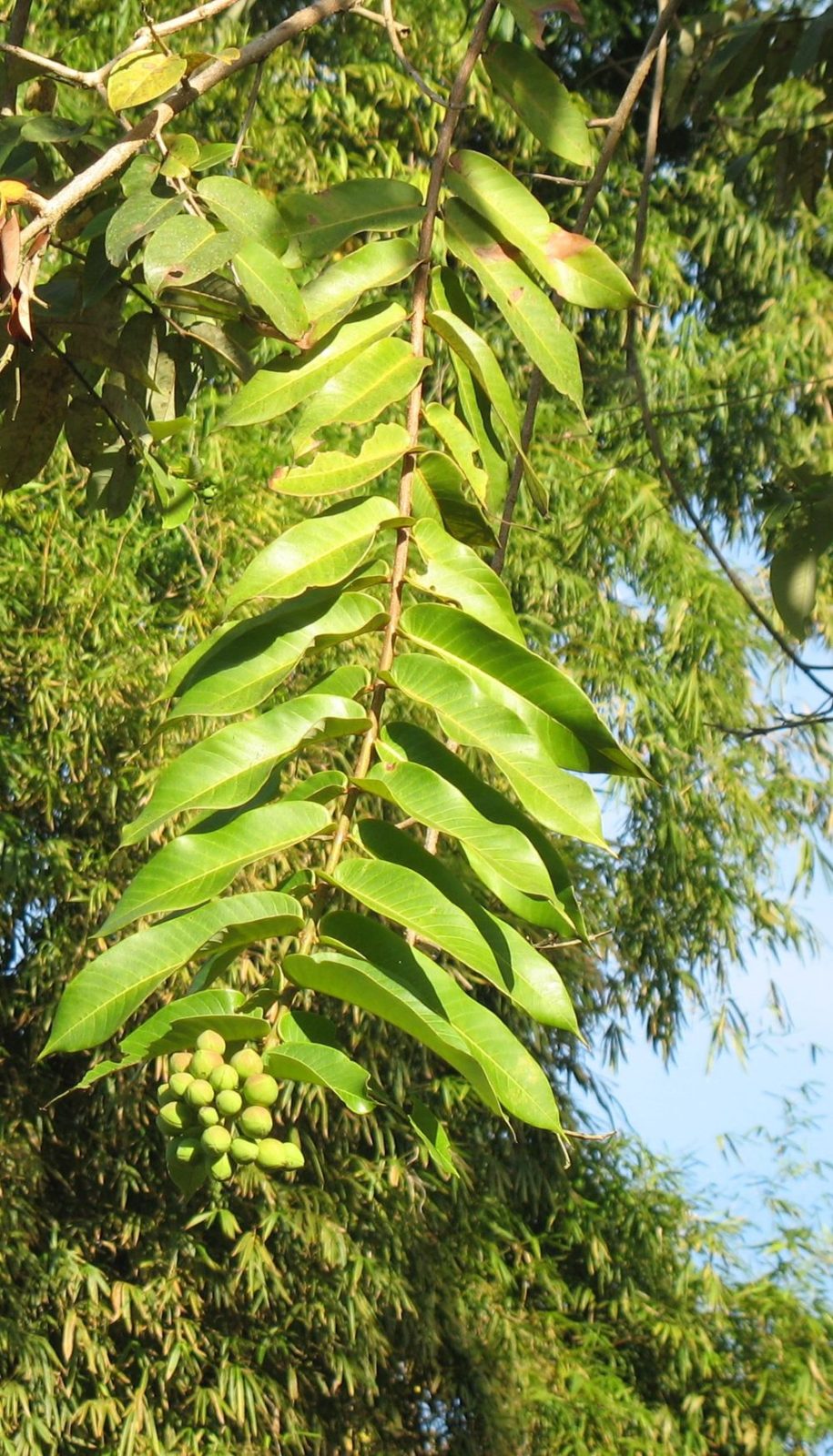
Tone ten is a tree growing in humid forest areas that we have seen numerous times between Luang Prabang and Phongsaly. It is very recognizable, particularly due to its foliage: it has a narrow, straight trunk, sometimes forked at the base, with long angular branches reaching toward the ground. Each of them is covered evenly and on the same side by two rows of thick, oval leaves, which are dark green on top and grey-green underneath, with profoundly marked nerves. Large clusters of floral buttons grow at the extremity of each branch. Each flower has six white petals, around a tuft of stamens. The flowers fall quickly, after which six fleshy sepals remain on the tree, forming a star, with the fruit in the centre of the formation, in a round, tough-skinned capsule.
This tree belongs to a very small botanical family comprised of only two genres and seven species. What interests us here is Duabanga grandiflora; the first part of its name stems from one of the minority languages of Tripura, a state in northeast India: Duyabangga. It is a species found in the lower areas of the rain forests of South and South-east Asia.
In Laos, this tree has numerous names: in Phongsaly, more often than not it is called tone lin ngo, one also hears tone sa phay. The latter name is interesting because “phay” applies to types of tiles made of grass and woven to cover the roofs of huts; now, the regular arrangement of the leaves on the branch of the Duabanga can make us think of tresses. In French, we have arbitrarily taken the commercial name for this wood: lampati. In fact, tone ten is a soft, smooth wood of a beautiful colour, from which one can make numerous objects: the Hmong use the wood in construction of their houses and to make pestles for pounding rice.
In international commerce, tone ten is suggested for making small pieces of furniture, veneers, packing cases, matches, toys, and any object in turned wood; one can also make pulp paper. Because this tree grows rapidly, we tell the wood merchants that it could be “the foundation of a lasting industry, without causing any loss of the rain forest… “
Most happily, the tone ten is not, to our knowledge, exploited industrially, nor does it appear on the lists maintained by the Centre for International Forestry Research of trees to be protected or replanted. One can, therefore, continue to enjoy its beautiful white flowers which are offered, so we were told by an elderly man we encountered, in Buddhist temples during the month of April.
Tone ten est un arbre des forêts humides que nous avons vu à plusieurs reprises entre Louang Prabang et Phongsaly. Il est très reconnaissable à l’architecture particulière de son feuillage; d’un tronc mince et droit, parfois formant une fourche à la base, partent de longues branches anguleuses qui se déploient vers le sol; chacune d’elle est couverte régulièrement et du même côté de 2 rangées de feuilles oblongues, épaisses, vert foncé sur le dessus, vert gris en dessous, aux nervures profondément marquées. C’est à l’extrémité de ces branches qu’apparaissent de grosses grappes de boutons floraux. Chaque fleur a 6 pétales blancs, qui tombent rapidement, autour d’une houppette échevelée d’étamines; après leur chute subsistent sur l’arbre 6 sépales charnus, en forme d’étoile avec au centre le fruit en formation; celui-ci est une capsule arrondie à l’enveloppe coriace.
Cet arbre appartient à une toute petite famille botanique qui ne compte que 2 genres et 7 espèces. Celle qui nous intéresse ici, Duabanga grandiflora, a été nommée à partir de son nom dans une langue indienne (Tripura), Duyabangga. C’est une espèce que l’on trouve dans les parties basses des forêts pluvieuses du Sud-est Asiatique et de la Chine.
En Lao cet arbre a plusieurs noms, à Phongsaly on le nomme plutôt tone lin ngo, on entend aussi tone sa phay; ce dernier terme est intéressant car « phay » s’applique aux sortes de tuiles d’herbe à paillote tressées pour couvrir les maisons ; or la disposition régulière des feuilles sur la branche de Duabanga peut en effet faire penser à un tressage. En français nous avons repris arbitrairement le nom donné dans le commerce à ce bois : lampati. En effet tone ten a un bois léger et lisse d’une belle couleur or avec lequel on peut faire de nombreux objets; chez les Hmong « le bois est employé dans la construction des maisons et la fabrication des pilons à riz ».
Dans le commerce international il est proposé pour fabriquer du petit mobilier, des plaquages, des caisses d’emballage, des allumettes, des jouets et tout objet en bois tourné; on peut aussi en faire de la pâte à papier. Comme il pousse très rapidement, nous disent les marchands de bois, il peut être « la base d’une industrie durable sans dommage pour la forêt pluvieuse »…










Tone ten is a tree growing in humid forest areas that we have seen numerous times between Luang Prabang and Phongsaly. It is very recognizable, particularly due to its foliage: it has a narrow, straight trunk, sometimes forked at the base, with long angular branches reaching toward the ground. Each of them is covered evenly and on the same side by two rows of thick, oval leaves, which are dark green on top and grey-green underneath, with profoundly marked nerves. Large clusters of floral buttons grow at the extremity of each branch. Each flower has six white petals, around a tuft of stamens. The flowers fall quickly, after which six fleshy sepals remain on the tree, forming a star, with the fruit in the centre of the formation, in a round, tough-skinned capsule.
This tree belongs to a very small botanical family comprised of only two genres and seven species. What interests us here is Duabanga grandiflora; the first part of its name stems from one of the minority languages of Tripura, a state in northeast India: Duyabangga. It is a species found in the lower areas of the rain forests of South and South-east Asia.
In Laos, this tree has numerous names: in Phongsaly, more often than not it is called tone lin ngo, one also hears tone sa phay. The latter name is interesting because “phay” applies to types of tiles made of grass and woven to cover the roofs of huts; now, the regular arrangement of the leaves on the branch of the Duabanga can make us think of tresses. In French, we have arbitrarily taken the commercial name for this wood: lampati. In fact, tone ten is a soft, smooth wood of a beautiful colour, from which one can make numerous objects: the Hmong use the wood in construction of their houses and to make pestles for pounding rice.
In international commerce, tone ten is suggested for making small pieces of furniture, veneers, packing cases, matches, toys, and any object in turned wood; one can also make pulp paper. Because this tree grows rapidly, we tell the wood merchants that it could be “the foundation of a lasting industry, without causing any loss of the rain forest… “
Most happily, the tone ten is not, to our knowledge, exploited industrially, nor does it appear on the lists maintained by the Centre for International Forestry Research of trees to be protected or replanted. One can, therefore, continue to enjoy its beautiful white flowers which are offered, so we were told by an elderly man we encountered, in Buddhist temples during the month of April.
Tone ten est un arbre des forêts humides que nous avons vu à plusieurs reprises entre Louang Prabang et Phongsaly. Il est très reconnaissable à l’architecture particulière de son feuillage; d’un tronc mince et droit, parfois formant une fourche à la base, partent de longues branches anguleuses qui se déploient vers le sol; chacune d’elle est couverte régulièrement et du même côté de 2 rangées de feuilles oblongues, épaisses, vert foncé sur le dessus, vert gris en dessous, aux nervures profondément marquées. C’est à l’extrémité de ces branches qu’apparaissent de grosses grappes de boutons floraux. Chaque fleur a 6 pétales blancs, qui tombent rapidement, autour d’une houppette échevelée d’étamines; après leur chute subsistent sur l’arbre 6 sépales charnus, en forme d’étoile avec au centre le fruit en formation; celui-ci est une capsule arrondie à l’enveloppe coriace.
Cet arbre appartient à une toute petite famille botanique qui ne compte que 2 genres et 7 espèces. Celle qui nous intéresse ici, Duabanga grandiflora, a été nommée à partir de son nom dans une langue indienne (Tripura), Duyabangga. C’est une espèce que l’on trouve dans les parties basses des forêts pluvieuses du Sud-est Asiatique et de la Chine.
En Lao cet arbre a plusieurs noms, à Phongsaly on le nomme plutôt tone lin ngo, on entend aussi tone sa phay; ce dernier terme est intéressant car « phay » s’applique aux sortes de tuiles d’herbe à paillote tressées pour couvrir les maisons ; or la disposition régulière des feuilles sur la branche de Duabanga peut en effet faire penser à un tressage. En français nous avons repris arbitrairement le nom donné dans le commerce à ce bois : lampati. En effet tone ten a un bois léger et lisse d’une belle couleur or avec lequel on peut faire de nombreux objets; chez les Hmong « le bois est employé dans la construction des maisons et la fabrication des pilons à riz ».
Dans le commerce international il est proposé pour fabriquer du petit mobilier, des plaquages, des caisses d’emballage, des allumettes, des jouets et tout objet en bois tourné; on peut aussi en faire de la pâte à papier. Comme il pousse très rapidement, nous disent les marchands de bois, il peut être « la base d’une industrie durable sans dommage pour la forêt pluvieuse »…


